download72b9_-_Reform_Movements.ppt
- 2. SOCIAL REFORM ORGANIZED ATTEMPT TO IMPROVE WHAT IS UNJUST OR IMPERFECT
- 4. THE GREAT AWAKENING 1730-1740 Religious movement that swept through the colonies Led by Jonathan Edwards Impact: 1-Growth of churches forced colonists to be more tolerant of religious differences Spread of democratic feelings in the colonies
- 5. SECOND GREAT AWAKENING 1800S Stresses free will rather than predestination Revivals encourage people to reform their lives Charles Finney taught that individual salvation is the first step to the reform of a society
- 7. DOROTHEA DIX Fights for mentally ill and prisons Legislature funds mental hospitals Persuades nation to treat mentally ill as patients, not prisoners Improves prison’s conditions (low supplies, went hungry, multiple people per cell) ; banned cruel punishments; shorter sentences for minor crimes;
- 8. TEMPERANCE MOVEMENT This was a campaign against alcohol abuse in 1820. Alcohol abuse and drunkenness was widespread throughout the nation in the 1800s among men, women, children. Families faced wife beatings, child abuse, and the breakup of families. As a result many states outlawed sale of alcohol.
- 11. EDUCATION Public Schools: • Horace Mann fought for rights in Mass. • Training for teachers • Higher wages • States passed laws requiring education • Taxed-supported school districts • Built colleges
- 12. African American • North: separate school houses • Many Americans were very hostile towards these schools; burning school, attacking the teachers • 1854, 1st African-American college in Penn.
- 13. Disabilities • 1817: 1st school for the deaf • 1832: 1st school for the blind; the system of Braille was constructed
- 14. WOMEN’S RIGHTS Sojourner Truth • Free slave in 1827 • Effective women’s rights leader • Fought against slavery • Traveled all over the nation, giving speeches • Pres. Lincoln chose her to be a counselor to the freedmen in Washington
- 15. Elizabeth Stanton • Fought for women’s rights • Women’s suffrage (the right to vote) • Women’s equality in the home, work, education, church, own property • Seneca Falls Convention • Wrote “Declaration of Sentiments” • Similar to the Declaration of Independence • Advocated that women were created equal, too.
- 16. ABOLITIONIST MOVEMENT: 1830 a person who wants to end slavery nationwide Frederick Douglas • Runaway slaved that spoke out against slavery as a slave and while in hiding. • Taught himself how to read and write. • Wrote a book about his life as a slave. • 1847, white friends bought his freedom.
- 17. Harriet Tubman • “Black Moses” • Runaway slave • Risking her freedom and life, she returned to the South 19 times, freeing over 300 slaves • Underground Railroad: network of abolitionists, helping slaves escape to North or Canada (STORY) It was a chain of homes and farms where escaped slaves could go her help.
- 18. William Lloyd Garrison • White abolitionist • 1831 Wrote “The Liberator” antislavery newspaper • Told Congress and the world that slavery must be abolished • Est. National Antislavery Society
- 19. Harriet Beecher Stowe • “Uncle’s Tom Cabin” 1852 • Was a slave who was whipped to death by his master • Shows the evils of slavery and the injustice of the Fugitive Slave Act. • The gains wide support in the North: saw slavery as a moral issue • South objective to the book: did not show the true picture of a slave’s life. Book was banned in the South


















